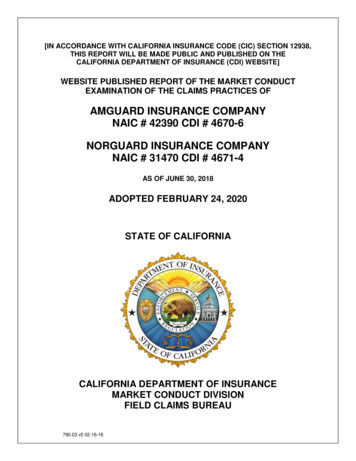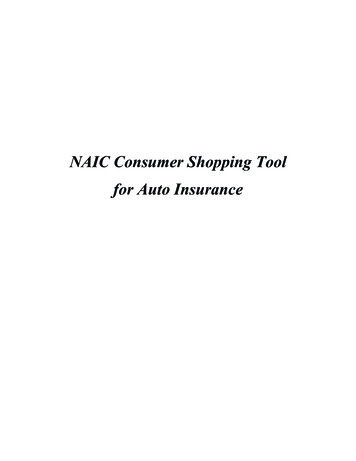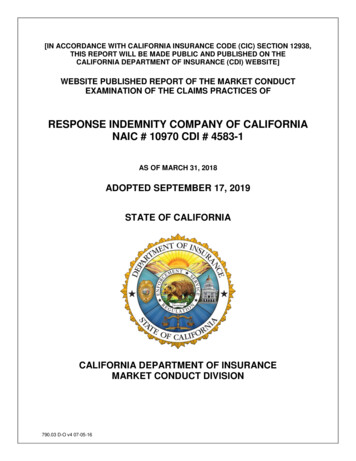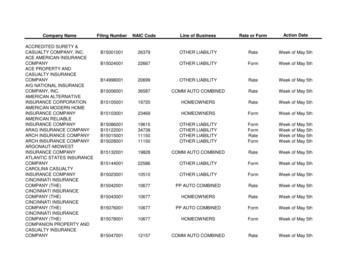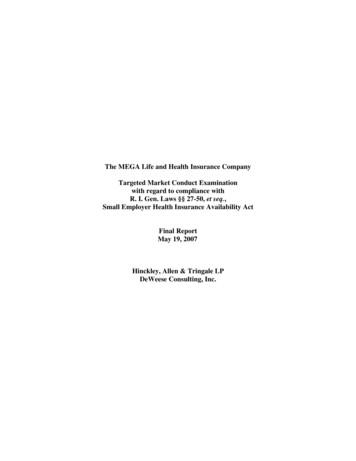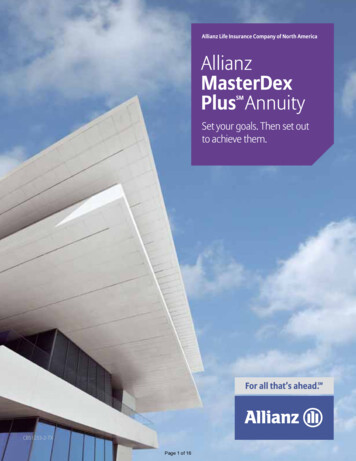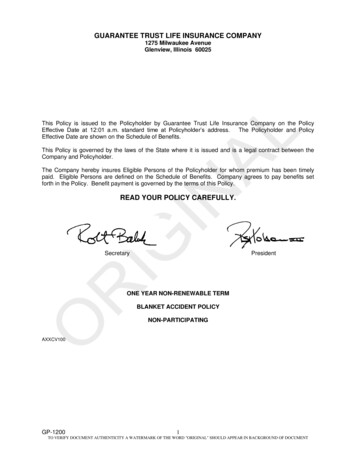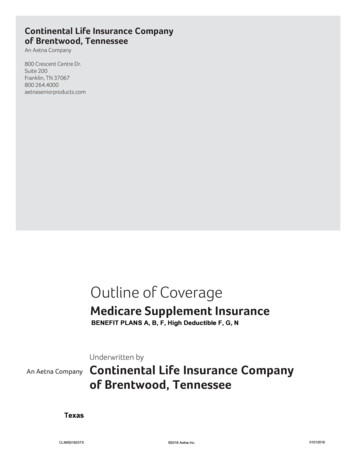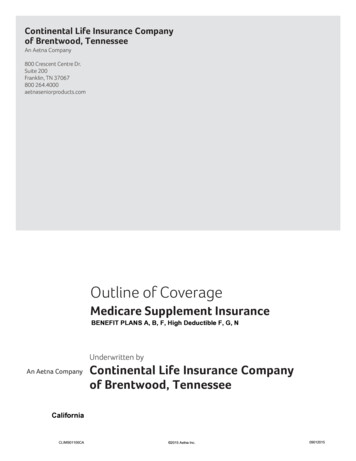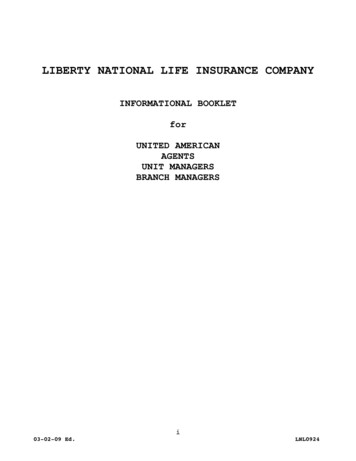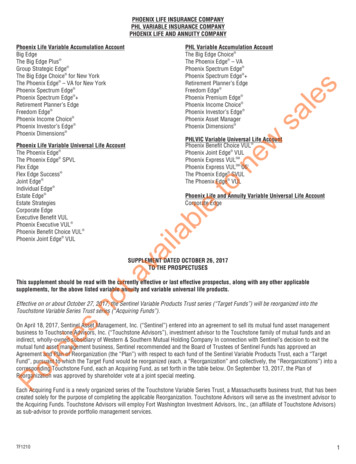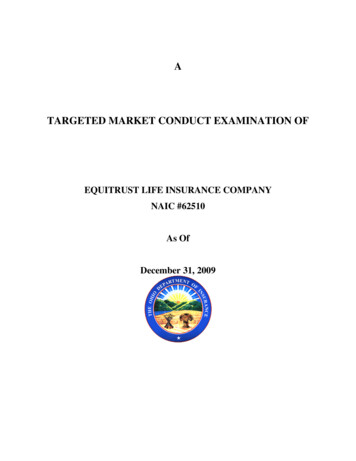
Transcription
ATARGETED MARKET CONDUCT EXAMINATION OFEQUITRUST LIFE INSURANCE COMPANYNAIC #62510As OfDecember 31, 2009
50 West Town StreetThird Floor – Suite 300Columbus, OH 43215-4186(614) 644-2658www.insurance.ohio.govJohn R. Kasich, GovernorMary Taylor, Lt. Governor/DirectorHonorable Mary TaylorLt. Governor/DirectorOhio Department of Insurance50 West Town Street Suite 300Columbus, Ohio 43215Director:Pursuant to your instructions and in accordance with the powers vested under Title 39 ofthe Ohio Revised Code, a targeted market conduct examination was conducted on theOhio business of the following:EquiTrust Life Insurance Company NAIC# 62510The examination and risk assessment was conducted at the Company’s statutory homeoffice at:7100 Westown ParkwayWest Des Moines, Iowa 50266-5997A report of the examination is enclosed.Respectfully submitted,June 13, 2011DateChief, Market Conduct DivisionAccredited by the National Association of Insurance Commissioners (NAIC)Consumer Hotline: 1-800-686-1526TDD Line: (614) 644-3745Fraud Hotline: 1-800-686-1527(Printed in house)OSHIIP Hotline: 1-800-686-1578
TABLE OF CONTENTSFOREWORD . 1EXECUTIVE SUMMARY . 1SCOPE OF EXAMINATION. 2METHODOLOGY . 2COMPANY OPERATIONS . 3NEW BUSINESS AND REPLACEMENTS REVIEW FINDINGS . 3AGENT TERMINATIONS . 8COMPLAINT HANDLING . 8ATTACHMENT . 10
FOREWORDThis examination and risk assessment was conducted under authority provided under OhioRevised Code (“R.C.”) 3901.011.EXECUTIVE SUMMARYThis examination is a targeted market conduct examination of EquiTrust Life InsuranceCompany (“Company”) by the State of Ohio as it relates to the Company’s suitabilitycompliance program for its fixed, individual annuity products for the period of January 1, 2003,through December 31, 2009, (the file review was conducted on annuities issued, replaced, orsurrendered, during the period of March 1, 2007, through December 31, 2009). The examinationbegan October 4, 2010 and concluded October 15, 2010.A review of complaints indicated several areas of concern: Allegations of fraud, misrepresentation or forgery; Agents not giving all information on policy features; A general lack of understanding on the annuitant’s part of exactly what they werepurchasing.The most significant areas of concerns are: The major reason for the examiner’s inability to determine suitability was the FinancialNeeds Analysis form used by the Company. There were three versions of the formreviewed and each variation was lacking in its own way. 19 of the new business and replacement files reviewed were identified as being possibleunsuitable transactions. There were three instances of replacements not being included on the Company’sreplacement register.Page 1 of 11
SCOPE OF EXAMINATIONThe basic business areas included as part of the examination included:A.B.C.D.E.F.ComplianceNew Business and ReplacementsSurrendersAgent TerminationsMiscellaneous-including policy loans and marketing and sales materialComplaint HandlingEach business area has standards that were measured during the examination. Some of thestandards have specific statutory guidance; others have specific company guidelines orcontractual guidelines.The focus of the examination was on the procedures and methods used by the Company toachieve compliance with applicable Ohio statutes and rules involving the issuance of fixed,individual annuity products. This included an analysis of how the Company communicates itsinstructions and philosophy with its employees, agency force, and national marketingorganizations.This examination report is a report by test, rather than a report by exception, and all standardsand tests are described and the findings indicated.METHODOLOGYThis examination is based on the standards and tests for a market conduct examination of a lifeand annuity insurer found in Chapters 16 and 19 of the NAIC Market Regulation Handbook andon applicable Ohio statutes and rules.Some of the standards were measured using a single type of review, while others used acombination or all types of review. The types of review used in this examination fall into twogeneral categories: Generic and Sample.A “Generic” review indicates that a standard was tested through analysis of general data gatheredby the examiners, or provided by the Company in response to interrogatories or personnelinterviews conducted by the examiners.A “Sample” review indicates that a standard was tested through direct review of a randomsample of files selected using automated sampling software.Each standard is accompanied by a comment describing the purpose or reason for the standard.Findings are indicated and any examiner comments or observations are noted.Page 2 of 11
COMPANY OPERATIONSEquiTrust Life Insurance Company is a stock life insurance company, wholly owned by FBLFinancial Group, Inc. domiciled in Iowa and admitted to do business in forty-nine states and theDistrict of Columbia.2009 Annuity ConsiderationsOhio Individual Ordinary 26,110,805National Individual Ordinary 497,406,379FILE REVIEW METHODOLOGY:The findings are based on the standards for a market conduct examination of a life and annuityinsurer according to applicable Ohio statutes and rules, including Ohio Administrative Code(“OAC”) 3901-6-13 and 3901-6-14.NEW BUSINESS AND REPLACEMENTS REVIEW FINDINGSStandard 5: Marketing and SalesThe insurer has suitability standards for its products as required by OAC 3901-6-13 (5), (7), and(8).Standard 3: Marketing and SalesThe insurer‘s rules pertaining to insurer requirements in connection with replacements areincompliance with OAC 3901-6-05.Standard 11: Marketing and SalesThe insurer has procedures in place to educate and monitor insurance agents/producers and toprovide full disclosure to consumers regarding all sales of products involving annuity products,and all sales are in compliance with OAC 3901-6-14 (E)(4)&(5) and R.C. 3901.21(A).Procedure ReviewMethodology: The examiners reviewed compliance procedure manuals and interviewedCompany personnel to determine how new business and replacements are reviewed andprocessed.Examiner Observations:The examiners reviewed the Company’s compliance procedure manuals and interviewedCompany personnel on how the issuance of annuities and the review of suitability are conducted.The Company appears to have a positive, corporate-wide attitude towards compliance and doingthings the right way. The Compliance Department works hard to get all employees involved inthe compliance process by making it a fun topic, and keeping the importance of compliance inPage 3 of 11
the forefront. Compliance is driven from the highest level down and that plays an important rolein the employees’ attitudes. The Company has instituted a “Compliance in Action” team thatfocuses on the role of compliance in every day work life and also is planning to begin the newyear with a new compliance-related theme that will send a positive message about complianceimportance.There are four committees throughout the Company that play different roles in assuringcompliance. They are the Corporate Compliance Committee, Internal Audit Department, MarketConduct Committee, and Complaint Committee. The link to all the committees is theCompliance Department. The Corporate Compliance Committee is made of all department headsand basically is kept informed of what has occurred within the Company and what is beingimplemented. One of the functions of the Internal Audit Department is to test insurance companyoperational policies and procedures for compliance with internal and external processes andregulatory requirements. The Market Conduct Committee receives input from the ComplaintCommittee and Compliance Department and review trends and analysis performed by these areasto see if any further actions are needed to handle issues that have been uncovered. TheComplaint Committee (made up of all sections including legal, marketing, licensing, and newbusiness) reviews current trends and performs analysis on complaints to determine how to fix anissue that has arisen through a complaint. All committees are driven by the analysis and trendingreports developed by the Compliance Department; however, some committee, such as theCorporate Compliance Committee and the Audit Committee also address a number ofcompliance issues. Communication is very important between all parties and meetings are heldquarterly, but in some cases, can be set up on an “as needed” basis to address immediateconcerns.The Company meets the statute requirements of OAC 3901-6-13 by maintaining writtenprocedures (the Company has a procedure manual in place for handling suitability issues) andconducting periodic reviews of agent submissions. The Company also submits to IMSAquarterly reviews that encompass suitability.The Company developed and instituted a mechanized review system in mid-2008 that enables apolicy-by-policy review of suitability. When an application comes in, the New Business areaenters all information into the system and this information is transmitted to an individual whoseresponsibility it is to review each application for suitability. The major factors that areconsidered are assets and expenses. The examiners objections to this review will be discussed ingreater detail in the ‘File Review’ section. Statistics are gathered on a quarterly basis and arefunneled to the Market Conduct Committee for review to determine if further action iswarranted.In addition to the policy-by-policy review, the Company performs trending and analysis on avariety of tasks including: policies not issued, terminated or not taken polices, unreportedreplacements, complaints, replacements, surrenders/transfers, and LIMRA Caps (which arequestionnaires sent to every applicant to obtain feedback on whether the person knew what theywere purchasing and the overall rating of the sales process).The Company has anti-laundering procedures in place and has developed guidelines, proceduresand controls on how luncheons or senior forums run by agents to solicit applications fromPage 4 of 11
seniors are conducted (all have to be pre-approved). The Company’s pre-approval requirementsextend to all advertising materials, including the use of the Company name or any reference tothe Company’s products.The Company also has a conservation program on applications that have been surrendered. Acustomer service person spends one day a week calling the individuals in an attempt to conservethe business.No issues were identified on the sales and marketing materials, policy contracts or disclosuresused by the Company. All meet the statute requirements.To improve the annuity suitability review process and in preparation for the suitability modellaw, the Company developed and instituted a new suitability review process in July of 2008. Asa first step in the process, each new business annuity application is submitted to the Des Moines,Iowa, office for processing. The “processing” involves data entry of application details, assets,expenses and product details. Once data entry is complete, the data is funneled through anactuarial formula that computes a “number” that will end up being the key determining factor forapproval of the annuity application. (The formula includes net assets minus net expensescompared to the present value of net needs of the person. If the result is a “positive” number, theapplication will be issued). Then the annuity application is electronically forwarded to adesignated suitability review person.The “suitability review representative” works through a queue of files that are received from theNew Business area. All of the application, product and suitability form information are availablefor review in a PDF document; however, there are two apparent “red flags” that would trigger arejection of the application. One would be if the annuity sale involves a replacement of anexisting policy that has been in-force at the prior company for less than three years – that salewould be rejected. A second “red flag” would be if the “actuarial computation number” fallsbelow the pre-established threshold of acceptance – which appears to occur only rarely. For themonth of September, 430 new annuity files were reviewed with approximately 20 denied.Additionally, as mentioned earlier, the value of the applicant’s home is factored into their “liquidasset” calculation – which seems to falsely inflate that side of the equation - possibly resulting inan inordinate number of annuity approvals, possibly contributing to a number of unsuitable sales.However, the newest version of the Financial Needs Analysis form (January, 2011) will nolonger include any real estate equity of any type as a liquid asset.The next step in this process involves the Compliance Department running a random sample andreview of the list of applications by pre-determined guideline like missing information,inconsistencies between the application, the financial needs form, and the money received, anyagent trends, unreported replacements, etc.The third step involves the review conducted by an informal working that meets on a regularbasis to discuss the overall application review process, form adjustments, regulatory changes,procedures, complaints, and other statistics for any improvements that may be warranted.Page 5 of 11
File ReviewMethodology:The examiners reviewed a sample of 50 Ohio new business and replacement policies on fixedannuity contracts issued during the examination period.Examiner Observations:The major focus of the new business and replacements involved the issue of annuity suitabilityand the Company’s oversight of its products. During the course of the review, there were 19instances of possible unsuitable sales (38%).Findings:New Business and Replacement 0311990%62%The standard for compliance is 90%. The Company’s performance is below this standard.The major reason for the examiner’s inability to determine suitability was the Financial NeedsAnalysis forms used by the Company. There are three versions of the form (ET-2506 03-06, 0408, and 07-09). The Company has tried to make improvements with each variation but each islacking in its own way.Version 03-06: Annual Gross Income: ranges are too wide to be able to make a common sense decisionon suitability. For example, the first range shows income of 0-99,999. There is asignificant difference in the decision-making process if the person is making 25,000 ayear or 99,000. The net worth category has ranges that are too wide. For example, the first choice is 0%20%. This means that the initial premium being invested is either 0% of the owner’s networth or 20%. Again, this is too far a range to determine if the sale was suitable. There is no specific liquidity or emergency needs question on the form. The onlyquestion included is if the owner has “considered the surrender charge period of theproduct applied for in relation to the period of time in which you will need the fullaccount value.” More specifics as to the person’s current assets would be beneficial. There is no occupation provided on the form. Net worth is determined using value of the owner’s home. This is a major issuethroughout the review, because it artificially inflates the assets. Most companies useliquid assets, so real estate is not included (unless this happens to be rental income, land,etc.).Version 04-08: Removed the range categories. There is no specific liquidity or emergency needs question on the form. The onlyquestion that somewhat addresses it is “Do you anticipate any material changes in yournet worth, living expenses, or liquid assets during the withdrawal-penalty period of thisannuity?”Page 6 of 11
Added a second page that has a breakdown of sources of annual income and annualexpenditures and current invested assets. Again, net worth is determined using value ofthe owner’s home. This is a major issue throughout the review, because it artificiallyinflates the assets. Most companies use liquid assets, so real estate is not included (unlessthis happens to be rental income, land, etc.).There is no occupation on the form.There is no tax status question on form.There is no question for risk tolerance.No specific percentage or amount for any surrender charges that occurred if the file was areplacement.Version 07-09: Matches the same issues on the 04-08 form but provides additional information requestedon replacements and trusts. There are no ranges of any kind on this form. Eliminated the breakdown of assets and expenses. Now only show the total of each. Removed the “no response” box option that was included on other forms. The inclusion of home value in the determination of net worth is still an issue. (Note: inan interview with the Compliance Manager and the exam coordinator, the home valuewas not supposed to have been included any longer. The Company is developing a newversion of the form and it is expected that this change will be made).Additional Exam Findings:During the replacement file review, surrender charge information from the prior company wasnot consistently provided (especially on older applications). The Ohio Department ofInsurance’s (“Department”) position is that the charges applied to move to EquiTrust is a majorfactor in determining suitability and if this information is not provided, the agent and thecompany are not in a position to make a thorough evaluation of the recommendation. TheCompany has addressed this issue with the newest version of the Financial Needs Analysis form.New business and replacements issued without financial information:Examiner Observations:Of the 50 files reviewed, 5 had the “No Response” box on the suitability form checked. TheFinancial Needs form did not contain a question that allowed the applicant to avoid providingfinancial information if they so chose. Only specific questions had a box for a “No Response”choice and this is only on the older version of the form. Most involved the ‘net worth’ question.There was no trend of any agents possibly abusing this question in order to get a questionableapplication issued. The newest version of the form does not have this box any longer and thereis also a comment on the top of the form that advises the potential annuitant that if they chose tonot provide any information, the application may not be issued.Page 7 of 11
New Business/Replacements issued over maximum allowable age:Examiner Observations:There were no new business/replacement policies in the sample issued on individuals over theCompany’s allowable maximum issue age.Unreported Replacements:Examiner Observations:A review of the Company’s replacement register and applications was conducted to check forany unreported replacements. There were 3 policies found that were marked as replacements onthe applications, but were not included on the replacement register. All 3 involved situations inwhich the Company handled the transaction as a replacement, but did not include on register,These are all considered viol
EquiTrust Life Insurance Company is a stock life insurance company, wholly owned by FBL Financial Group, Inc. domiciled in Iowa and admitted to do business in forty-nine states and the District of Columbia. 2009 Annuity Considerations Ohio Individual Ordinary National Individual O
